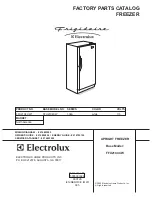
3 |
P a g e
December 22, 2020
OPERATION &
CARE OF THE CABINET
:
CAUTION –
This unit contains R290, a flammable hydro-carbon refrigerant. If the unit is not functioning
properly, remove it from service, and call an HVAC technician certified to handle flammable refrigerants.
Do not operate the freezer unless the louver grills are properly secured in place
.
Simply plug the freezer into an outlet following the guidelines above. The compressor will run until the
freezer shuts off when it reaches the thermometer set point.
Your new C. Nelson mfg. low temperature cabinet represents the finest in engineering design, quality of
material and craftsmanship effort. It will give you many years of trouble-free service with a minimum of
attention.
The easy-to-clean exterior surfaces should be wiped off regularly with a lukewarm, mild detergent solution.
Do not use any solvent-type cleaners, that could attack the plastic and vinyl parts of the
cabinet. Never use
abrasive cleansers or scoring pads as these will mar the surface. Never clea
n the lids or cabinet with
steam or extremely hot water. DO NOT WASH LIDS IN A DISHWASHER.
From a sanitation standpoint, it is important that the interior of the cabinet also be cleaned periodically.
Before cleaning the interior, the unit must be Defrosted. See Defrost instructions before proceeding. A
damp cloth using the same type of lukewarm detergent solution used for the exterior can be used on the
interior. After cleaning, wipe the interior of the cabinet dry, replace the lids and plug in the freezer. Wait
several hours to ensure that the freezer has reached its operating temperature before reloading the cabinet
with product. No oiling of the equipment is required.
DEFROSING & PREVENTIVE MAINTENANCE
OF THE CABINET
:
Defrosting
: The freezer should be defrosted every 2-4 weeks or as needed to avoid excessive frost build-
up. Excessive frost build-up significantly degrades the freezers performance and reduces operating
efficiency.
To defrost the unit, remove the lids and the product. Unplug the unit or turn the switch to “OFF” position.
When the cabinet has warmed up, any remaining frost accumulation may be scraped off the walls
CAREFULLY
with a plastic or wood scraper. Never use a sharp or pointed metal scraper since it could
damage the finish or possibly pierce the walls or refrigerant tubing.
Wipe the interior of the cabinet dry. This would be a good time to clean the interior of the cabinet per the
instructions provided in OPERATION & CARE OF THE CABINET.
After the interior of the cabinet is dry, replace the lids and plug in the unit and/or turn the temperature
control to the “ON” position. Wait several hours to ensure that freezer has reached its operating
temperature before reloading the cabinet with product.
Cleaning Condenser
: The freezer’s condenser should be cleaned every 6-months by a qualified
HVAC
technician. To clean the condenser, unplug the unit before removing any louvers. Once the louvers are
removed, vacuum dust and debris from the coils and louvers using a soft brush attachment. Never use a
sharp or pointed tool to clean condenser coils to avoid risk of puncturing tubing. Vacuum the condenser
tunnel. Replace the louvers.
Plug in the unit and ensure that the temperature control is in the “ON” position.























